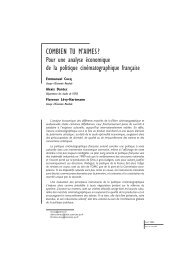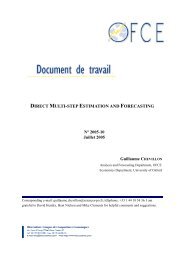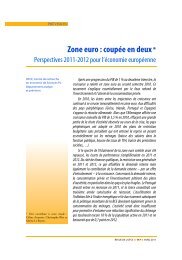N° 2005-09 Juin 2005 Guillaume Daudin* Jean-Luc Gaffard ...
N° 2005-09 Juin 2005 Guillaume Daudin* Jean-Luc Gaffard ...
N° 2005-09 Juin 2005 Guillaume Daudin* Jean-Luc Gaffard ...
Create successful ePaper yourself
Turn your PDF publications into a flip-book with our unique Google optimized e-Paper software.
Relocation: What Matters? Competition or/and a New Policy Mix2. The hypothesis of relocation in the current analysis and the obsession ofcompetitivenessCurrent economic analysis does not address directly the phenomenon of relocation. Sowe have to consider what could be its significance with respect to the results of new modelsthat are a mix of geographical and international economics.Within the standard analytical framework, relocation is nothing but an aspect of a core– periphery pattern, which would be reversed as a consequence of a reduction of transportcosts coupled with a huge differential of wages. In this perspective, the loss of ‘high’-wagemanufacturing jobs in the core would be associated with international trade and foreign directinvestment as induced by decreasing transport costs. This assertion is the essence of the socalleddeindustrialisation or relocation hypothesis.New economic geography modelling stresses technology in the standard way as the‘fundamental’ determining both the growth rate of different countries and the spatialdistribution of economic activities. The relevant attributes of technology in this case are localexternalities, transport costs, costs of communication of new ideas and knowledge, R&Dspillovers (Krugman and Venables 1995, Martin, Ottaviano 1999, Baldwin, Martin, Ottaviano2001). Technology, far from being a result of a process of innovation, is a pre-condition of it.Decreasing unit costs and increasing variety of goods that generates forward and backwardlinkages are an immediate outcome of the choice of introducing a new technology. Relocationfollows, but without creating co-ordination problems that would result in the reduction ofincome and the appearance of unemployment in the countries concerned with delocalisation.Within such an equilibrium framework, trade liberalisation and relocation fit in withindustrial clustering. Firms and consumers are more outward oriented. If market proximity isless important than local linkages as competitive forces to be taken into account by each firm,then industrial clustering will be more intense as a consequence of a deeper integration.Breaking the symmetry between supply and demand forces at the local level will inducechanges in the location of firms, but these changes cannot be considered as harmful when theydo not result in higher unemployment and lower income. On the one hand, specialisation issupposed to only induce changes in type of jobs in each cluster without global effect onemployment. On the other hand, real-income gains are supposed to flow from clustering ofindustries. This explains why industries are more highly clustered in the US than in Europe,without harmful effects on employment in any geographical area. Clustering is here a quasidynamicequilibrium. The only problem (not addressed in the equilibrium models) is a65








